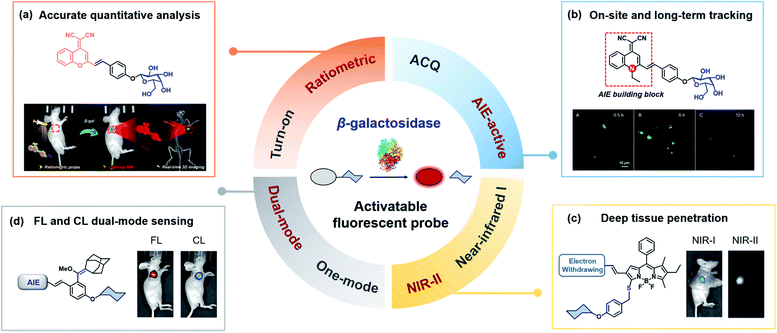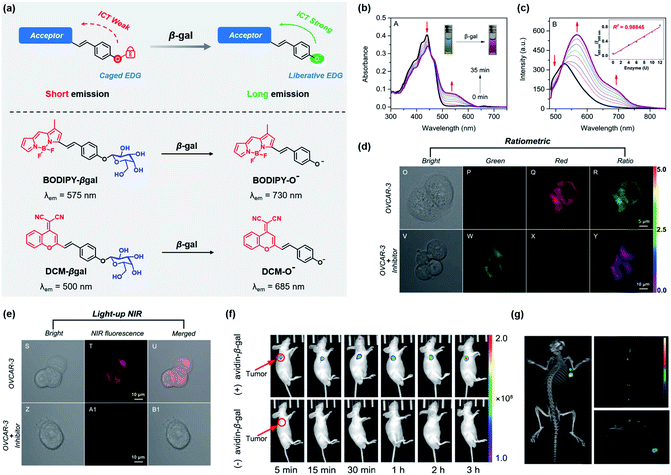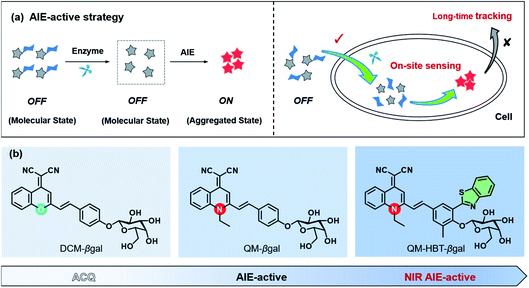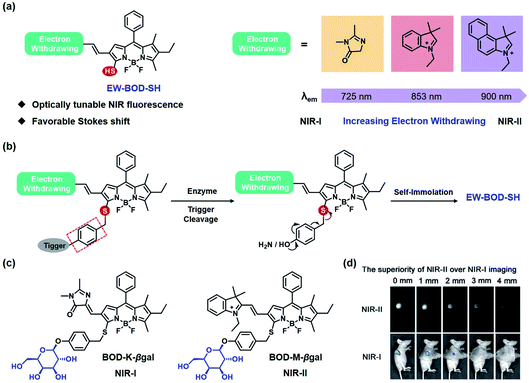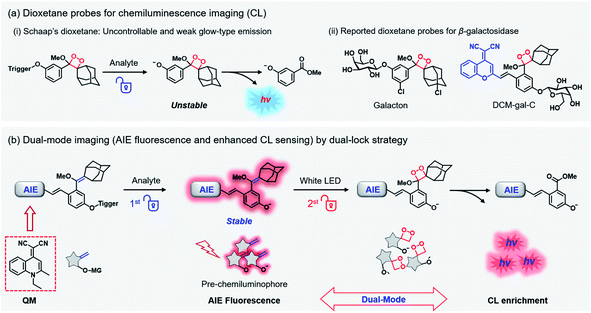 Open Access Article
Open Access ArticleEnzyme-activatable fluorescent probes for β-galactosidase: from design to biological applications
Yongkang
Yao
,
Yutao
Zhang
,
Chenxu
Yan
 ,
Wei-Hong
Zhu
,
Wei-Hong
Zhu
 and
Zhiqian
Guo
and
Zhiqian
Guo
 *
*
Key Laboratory for Advanced Materials, Institute of Fine Chemicals, Feringa Nobel Prize Scientist Joint Research Center, Frontiers Science Center for Materiobiology and Dynamic Chemistry, School of Chemistry and Molecular Engineering, East China University of Science and Technology, Shanghai 200237, China. E-mail: guozq@ecust.edu.cn
First published on 16th July 2021
Abstract
β-Galactosidase (β-gal), a typical hydrolytic enzyme, is a vital biomarker for cell senescence and primary ovarian cancers. Developing precise and rapid methods to monitor β-gal activity is crucial for early cancer diagnoses and biological research. Over the past decade, activatable optical probes have become a powerful tool for real-time tracking and in vivo visualization with high sensitivity and specificity. In this review, we summarize the latest advances in the design of β-gal-activatable probes via spectral characteristics and responsiveness regulation for biological applications, and particularly focus on the molecular design strategy from turn-on mode to ratiometric mode, from aggregation-caused quenching (ACQ) probes to aggregation-induced emission (AIE)-active probes, from near-infrared-I (NIR-I) imaging to NIR-II imaging, and from one-mode to dual-mode of chemo-fluoro-luminescence sensing β-gal activity.
1. Introduction
β-Galactosidase (β-gal), as a typical glycoside hydrolase enzyme, can catalyse the hydrolysis of the β-glycosidic bond and convert the lactose into monosaccharide. It is a widely held view that β-gal is closely associated with primary ovarian cancers and cell senescence.1–3 For instance, metastatic ovarian cancer cells (e.g. SKOV3 and OVCAR3) exhibit a higher level of β-gal activity relative to normal human cells.4 Moreover, β-gal is commonly used as a reporter enzyme to study gene expression and regulation in biological systems, especially for Escherichia coli β-galactosidase, which is well characterized and encoded by the LacZ gene.5–7 Various methods have been developed to evaluate β-gal activity for biological research, including colorimetry,8,9 electrochemistry,10,11 positron emission tomography (PET),12 magnetic resonance imaging (MRI)13–15 and so forth. For instance, chromogenic probe X-gal (5-bromo-4-chloro-3-indolyl-β-D-galactopyranoside) is known for β-gal expression staining in histology, but due to its poor cell-permeability, it needs to fix cells or sacrifice organisms, making it difficult to perform in vivo imaging.8,16,17Fluorescence techniques provide a powerful way to visualize dynamic biological processes in living cells and organisms owing to their high detection sensitivity, excellent resolution and non-invasive real-time detection abilities.18,19 In particular, fluorescence imaging in the near-infrared window (NIR-I, 650–900 nm; NIR-II, 1000–1700 nm) has gained more attention and been designed for biological analytes/microenvironmental factors.20–24 Comparison with the emission falling into the visible region, these NIR fluorophores could effectively decrease background interference and achieve deeper penetration with superior imaging qualities.25–27 In general, fluorescent probes are divided into two main categories of “always-on” probes and activatable probes. Indeed, activatable probes could switch the fluorescence from the “off” to the “on” state (turn-on probes) or adjust the dual-emission ratio (ratiometric probes) upon activation by a specific target, thus achieving a lower limit of detection and higher signal-to-noise ratio.28 Considering that current β-gal detection is generally based on β-gal-catalyzed enzyme reaction, elaborately activatable NIR fluorescent probes are expected to realize sensitive and real-time detection, thereby assessing the biological activity of β-gal with high specificity.
The primary themes for activatable probe design and application are the use of spectral characteristics of fluorophores and the strategy employed to regulate its responsiveness. The key properties of fluorophore scaffolds include finely tuning spectroscopic properties and brightness, regulating the wavelength to the NIR region, and uniting multiple modalities for β-gal imaging. Here, we focus on the latest progress in the design of enzyme-activatable fluorescent probes, especially for monitoring β-gal activity in live cells and in vivo application. We highlight the rational design strategy for constructing versatile platforms of activatable β-gal probes (Fig. 1), including from turn-on mode to ratiometric mode with accurate quantification, from aggregation-caused quenching (ACQ) to aggregation-induced emission (AIE)-active probes with long-term tracking properties, from the NIR-I to the NIR-II wavelength region with deeper penetration, and dual-modality of fluorescence and enriched chemiluminescence (CL) imaging with high sensitivity. In addition, we also constrain our survey to the β-gal-catalyzed reaction by removing the trigger moiety and liberating the activated moiety for magnetic resonance imaging (MRI) and photoacoustic imaging β-gal.
2. Turn-on NIR fluorescent probes for β-gal
Current fluorescent probes display “always-on” signals regardless of interactions with targets, which results in a low signal-to-background ratio and restricts the detection limit. In contrast, turn-on fluorescent probes can be specifically activated by biological targets with remarkable emission from a dark background, thus improving the sensitivity and resolution of bioimaging.29–31 Generally, turn-on probes for β-gal are built by covalently introducing a β-D-galactopyranoside group as the β-gal-triggered moiety into fluorophores, which could quench the initial emission (off-state). Upon reaction with β-gal, the locked fluorophores would be released and display bright fluorescence emission (on-state). According to this design strategy, Nagano et al. reported a wide range of turn-on probes, comprising conventional fluorescein dyes and its analogues for detecting β-gal, but most of their emission falls into the visible range.4,7,32,33In order to enhance the in vivo performance, much effort has been made to develop suitable NIR fluorophores as the signal moiety.34–39 As is well known, commercially available ICG dye – an FDA approved NIR contrast agent with good biocompatibility and biodegradability – is widely employed as a fluorescent reporter. Shabat and co-workers developed a turn-on NIR probe (QCy7-βgal) for the imaging of β-gal (Fig. 2), which contains a NIR cyanine fluorophore (QCy7) and an enzyme-activatable group (β-D-galactopyranoside).34 The only probe QCy7-βgal displayed almost no fluorescence in the NIR region. Upon incubation with β-gal, QCy7-βgal underwent a cleavage reaction with the broken β-glycosidic bond and subsequently released the active Cy7 fluorophore through self-immolation. Turn-on NIR emission at 720 nm was observed owing to the distinctive change in their π-conjugated system, along with an obvious color change from original yellow to dark (Fig. 2b and c). Based on the advantages of high selectivity and NIR fluorescence, the probe was successfully applied in living mice. As shown in Fig. 2d, the in vivo experiments indicated that QCy7-βgal exhibited a significant NIR fluorescence enhancement toward β-gal, showing good biocompatibility and a high signal-to-background ratio.
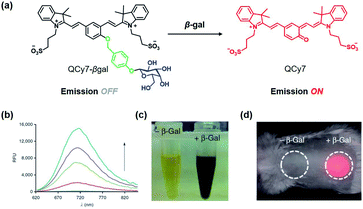 | ||
| Fig. 2 (a) Fluorescence response of the NIR fluorescent probe QCy7-βgal to β-gal. Fluorescence response (b), absorbance response (c), and in vivo imaging (d) of QCy7-βgal. | ||
Considering that de-acidification is a unique characteristic of lysosomes in senescent cells, it is important to distinguish senescence-associated β-galactosidase (SA-β-gal) from other endogenous β-gal. Very recently, Guo and co-workers presented two-dimensional fluorescent probes (KSA01 and KSA02) to specifically track cellular senescence (Fig. 3a).40 These probes were designed by endowing merocyanine-based fluorescent dyes with carboxyl groups, so that they could monitor senescence in a second dimension: lysosomal pH. Upon the addition of A. oryzae β-gal (pH 4.0), the galactose moiety of KSA02 was removed to liberate the phenolic hydroxyl moiety, showing green fluorescence at a short wavelength (534 nm) (Fig. 3b). Differently, upon adding E. coli β-gal (pH 7.4), KSA02 liberated the phenolic oxygen anion and emitted at a long wavelength (562 nm) (Fig. 3c). Furthermore, based on the fact that senescent cells exhibit higher lysosomal pH than ovarian cancer cells, the probes were successfully evaluated in senescent HL-7702 cells and ovarian cancer-associated SKOV-3 cells. As depicted in Fig. 3d, KSA02 mainly produced a red fluorescence in HL-7702 cells but a green fluorescence in SKOV-3 cells, indicating sensitive differentiation of SA-β-gal from cancer-associated β-gal.
3. Ratiometric probes for quantitative analysis
The library of activatable fluorescent probes with light-up and/or ratiometric modes could dramatically enlarge the quantitative determination. The light-up mode of probes could possess high sensitivity owing to enhanced fluorescent signals from a dark background.31 However, considering only a single emission channel, these turn-on probes inevitably suffer from analyte-independent interference, such as instrumental parameters and light-scattering by the detection environment.41 In contrast, ratiometric probes could achieve self-calibration by calculating the signal ratio of two or more independent channels, thereby providing accurate quantitative analysis.28,41,42 To date, several design strategies have been explored for ratiometric sensing of β-gal activities, including intramolecular charge transfer (ICT),16,42,43 Förster resonance energy transfer (FRET),44,45 excited-state intramolecular proton transfer (ESIPT),46etc.Recently, Guo et al. constructed two ratiometric NIR probes (DCM-βgal and BODIPY-βgal) for β-gal (Fig. 4a), which depends on optimizing the incorporated electron-withdrawing unit to regulate the ICT process.47,48 Specifically, dicyanomethylene-4H-pyran (DCM) and the 4,4-difluoro-4-bora-3a,4a-diaza-s-indacene (BODIPY) fluorophore are utilized as NIR signal reporters, and the D-galactose unit is functionalized as a β-gal triggered moiety. When reacting with β-gal, the D-galactose unit of DCM-βgal and BODIPY-βgal could be specifically hydrolyzed to form phenol, a strong electron-donating group (EDG), thus providing a remarkable ICT-based switch for ratiometric NIR analysis. For DCM-βgal, its initial absorption peak at 440 nm declined, and the new peak extended to 535 nm, accompanied by an obvious yellow-to-rose color change (Fig. 4b). The fluorescence signals remarkably decreased at 500 nm and concurrently increased at 685 nm, thereby obtaining a good linear relationship between the intensity ratio (I685 nm/I500 nm) and β-gal concentration (R2 = 0.98845) (Fig. 4c). In light of its ratiometric NIR mode, endogenous β-gal in OVCAR-3 cells was quantitatively detected and imaged by the probe DCM-βgal (Fig. 4d and e). More importantly, DCM-βgal allows for high resolution three-dimensional mapping of β-gal activity in living mice (Fig. 4f and g). Considering that DCM has been a commercial dye since 1989,49 DCM-βgal could be easily synthesized and employed as a potential optical tool for ratiometric measurement of β-gal under physiological conditions. And this work was also highlighted by Nature Methods due to its excellent abilities for real-time tracking β-gal in vivo.50
4. AIE-active probes for on-site sensing and long-term tracking
Fluorescent probes capable of long-term tracking of special enzymes or other biomarkers are in high demand for early detection of diseases.51–54 Even though current small-molecule fluorescent probes have advantages of quick diffusion and deep penetration into living cells, these probes and/or their enzyme-catalyzed products suffer from easily diffusing across the cell membrane and/or being extruded out. Thus, it is difficult to precisely obtain in situ information of these small-molecule activatable probes, owing to their limitation of on-site accumulation and retention time.19,32,55 Particularly, the aggregation-caused quenching (ACQ) effect is another hardship for these available fluorescent probes at high concentration, leading to distorted in situ signals.As a pioneering study, Tang and co-workers discovered a fascinating photophysical phenomenon, aggregation-induced emission (AIE).56–58 Different from typical ACQ fluorophores (e.g. fluorescein59 and rhodamine60), AIE luminogens (AIEgens) generally displayed weak or no fluorescence in their molecular state but strong fluorescence in their aggregated state. Notably, the more AIEgens aggregate, the brighter their emission becomes, making them become a kind of promising material for tracking biomolecules with high fidelity in living systems. Recently, some typical AIE fluorescent probes based on the tetraphenylethene (TPE) core have been reported for the detection of β-gal.61,62 For example, Ding and co-workers developed a β-gal-responsive AIE probe that could selectively identify and remove senescent cancer cells through enzyme-activatable self-assembly and efficient reactive oxygen species (ROS).62
However, the initial state of AIE-active probes before the probes interacting with targets of interest is generally “always-on”, thereby leading to a “false-positive” signal. In this regard, it is necessary to develop an AIE-active strategy to form in situ AIE nanoaggregates, enhancing retention for long-term imaging and performing turn-on fluorescence (Fig. 5a). Specifically, the AIE probes with a hydrophilic moiety display good solubility in the physiological environment; when reacting with enzymes, a highly efficient enzyme-catalyzed hydrolysis reaction could liberate hydrophobic AIEgens, followed by in situ aggregation to form nanoparticles with intensive emission at the activation site, and the nanoaggregates promote diffusion-resistant on-site sensing in living cells.
Recently, Guo et al. elaborately designed a new AIE building block of quinoline-malononitrile (QM), which just incorporates the N-ethyl group to replace the oxygen atom of the DCM core. Subsequently, an AIE-active probe (QM-βgal) was developed for tracking β-gal (Fig. 5b and 6a).63 Because of the hydrophilic β-gal-activatable unit bestowing favorable water-solubility, QM-βgal almost showed very weak emission in aqueous solution; while activated by β-gal, the hydrophobic QM-OH was in situ generated and converted into nanoaggregates, accompanied by remarkable fluorescent enhancement at 560 nm (Fig. 6b). Meanwhile, the plot of fluorescence intensity I560 nm against the concentration of β-gal shows a good relationship (R2 = 0.992) (inset of Fig. 6b). To verify that this AIE-active strategy could achieve on-site sensing and long-term imaging, the typical ACQ probe DCM-gal was chosen as a control for the in vivo imaging experiment. As shown in Fig. 6c and d, the incubation time in SKOV-3 ovarian cancer cells prolonged over 12 h, but the intracellular fluorescent signals from QM-βgal were still observed and accumulated with low background interference in living cells.
 | ||
| Fig. 6 (a) Chemical structure of QM-βgal. Fluorescence response (b), long-term cell images (c) and averaged fluorescence intensity (d) of QM-βgal. | ||
Furthermore, to extend the emission wavelength into the NIR region, a β-gal-active probe QM-HBT-βgal was elaborately synthesized by introducing the 2-(2-hydroxyphenyl) benzothiazole group as an external π-conjugated structure (Fig. 5b).64 The results of the Cell experiment revealed that QM-HBT-βgal could realize long-term NIR fluorescence imaging in SKOV-3 cells. Considering the high performance of QM-HBT-βgal and QM-βgal, it was believed that the AIE-active strategy provides a new pathway to design enzyme-activatable probes for on-site sensing and long-term tracking in living samples.
5. Activatable probes from NIR-I to NIR-II imaging
The above mentioned activatable probes with NIR-I emission (650–900 nm) show potential in vivo applications for living cells and organisms, while NIR-II imaging could provide greater tissue penetration with markedly suppressed photon scattering and significant improvements in spatial resolution with zero-autofluorescence in mammals. Intriguingly, fluorescence imaging in the NIR-II spectrum (1000–1700 nm) opens a new pathway for deep-tissue biological exploration.65,66 Nowadays, the primary challenge for NIR-II imaging is the limited availability of high-performance NIR-II fluorophores with both high brightness and biocompatibility. And various inorganic materials, such as quantum dots and lanthanide-doped nanoparticles, have also been explored as high spatial NIR-II contrasts. It should be noted that their long-term health risks due to the non-biodegradable feature need to be carefully considered.67–69 To date, the design of small molecule-based organic fluorophores for NIR-II imaging, especially to in vivo monitor β-gal activities is still a huge challenge.Towards enzyme-activated NIR-II probes, Zhao et al. established a universal platform with tunable emission from the NIR-I to the NIR-II region.70 The emission of BODIPY-based fluorophores (EW-BOD-SH) was effectively red-shifted to a longer wavelength via incorporating an electron-withdrawing group into the 3-position of the BODIPY core, which exhibited a long tail falling into the NIR-II region (1000–1300 nm) (Fig. 7a). Furthermore, this platform was engineered by attaching enzymic substrates into EW-BOD-SH through a self-immolative benzyl thioether linking spacer (Fig. 7b). When the designed probes were catalyzed and triggered by the specific enzyme, they would subsequently undergo a 1,6-elimination reaction to liberate the sulfur atom of thiol-modified BODIPY with enhanced electron-donating ability, thereby ultimately generating desired NIR emission with large Stokes shifts. In this way, diverse activatable probes could be designed for the NIR-I/NIR-II fluorescence sensing of enzymes (such as NTR, NQO1 and ALP).
More importantly, using a similar design strategy, Gu and co-workers successfully developed two turn-on NIR-I and NIR-II probes (BOD-K-βgal and BOD-M-βgal) to recognize β-gal in ovarian cancers (Fig. 7b), which were also incorporated with a D-galactose residue as a β-gal activatable trigger.71 Upon titration with β-gal, BOD-K-βgal and BOD-M-βgal displayed significant turn-on NIR-I or NIR-II responses, respectively. Furthermore, the in vivo ovarian tumor imaging was carried out in the SKOV3 subcutaneous xenograft nude mice. As shown in Fig. 7d, the obvious strong NIR-II signals of BOD-M-βgal could be observed even at a 2 mm depth, but the NIR-I signals of BOD-K-βgal were almost undetected even at 1 mm. These results further demonstrated that NIR-II imaging could penetrate deeper tissue and provide higher resolution than NIR-I imaging because of almost zero-autofluorescence and markedly suppressed photon scattering.
6. Dual-mode probes with AIE-active fluorescence and enriched chemiluminescence
Over the past decades, optical imaging (e.g. super-resolution imaging, photoacoustic (PA) imaging and chemiluminescence (CL) imaging) and other noninvasive imaging modalities (e.g. MRI and PET) have been rapidly developed for disease diagnosis and therapeutic intervention, thereby providing tremendous opportunities to monitor in vivo β-gal activity. For instance, He and Zhang et al. reported a photochromic fluorescent probe (NPG) for the super-resolution imaging of β-gal (Fig. 8).72 Due to the excellent photoswitching properties of spiropyran-based dye (merocyanine ↔ spiropyran), NPG could overcome the diffraction limit of light and visualize the β-gal distribution with nanoscale precision. Very recently, Chan et al. introduced a new photoacoustic scaffold (PA-HD) by reasonable modification of hemicyanine dye (O-HD) (Fig. 9a):73 replacing the oxygen atom with the sulfur atom to extend the absorption wavelength, enhance the extinction coefficient and attenuate the fluorescence quantum yield; adding the chloro group to adjust the phenolic pKa value ensures that PA-HD exists in deprotonated form after PA-HD-Gal reacts with β-gal in a physiological environment (Fig. 9b and c). Furthermore, PA-HD-Gal was successfully applied in PA imaging of β-gal detection (Fig. 9d).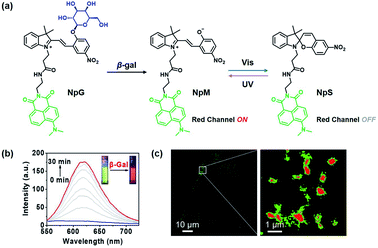 | ||
| Fig. 8 (a) Fluorescence mechanism of photochromic probe NpM@HSA. Fluorescence response (b) and super-resolution imaging (c) of β-gal in senescent cells. | ||
Given the advantage of the tissue-penetration depth of magnetic resonance imaging (MRI), Meade et al. developed a series of self-immolative β-gal-responsive contrast agents, and synthesized intermolecular and intramolecular architectures to optimize the coordination of water to Gd3+ (Fig. 10a and b).13 Among them, 6-C pendant carboxylate (10c) was demonstrated as an effective MR contrast agent in the mouse model, which exhibits a visible MR signal at the 4 h time point (Fig. 10c). Consequently, considering the diversity of imaging modalities, it would be a powerful strategy to design β-gal-activatable probes with synergetic fluorescence and other imaging modalities.
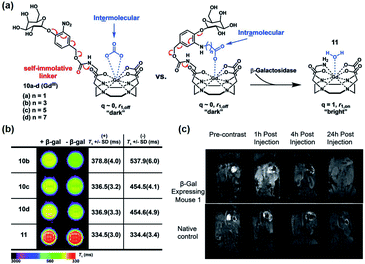 | ||
| Fig. 10 (a) Self-immolative MRI contrast agents with intermolecular or intramolecular architecture for β-gal detection. (b) MR information of (10b–d) ±β-gal at 7 T. (c) MR images of living mice. | ||
Recently, some researchers focus on CL imaging which produces photons through specific chemical reactions rather than light excitation. Because CL imaging doesn't require an exogenous excitation light, the limitations from tissue autofluorescence and light scattering could be effectively avoided, thus obtaining a much higher signal-to-noise ratio.74–76 However, current conventional CL probes, such as oxalate esters and luminol, were activated by the oxidation reaction and limited to the detection of oxidative species, making them difficult to real-time sense chemical or biological species. Schaap's adamantylidene-1,2-dioxetane with an analyte-responsive phenol trigger moiety emerged as a favored platform for CL imaging (Fig. 11a).77–79 Upon the removal of the trigger moiety, the resulting phenolate intermediate is unstable and undergoes an electron transfer event and decomposition, accompanied by the blue glow-type emission.
Based on Schaap's dioxetane, many dioxetane probes were developed for a variety of analytes, including β-gal discussed here. For example, Mason and co-workers used the commercially chemiluminescent probe (Galacton) together with the addition of a surfactant-dye adduct for in vivo detection of β-gal. Moreover, in order to extend light emission to the NIR region, Shabat and co-workers designed the probe DCM-gal-C through integrating the DCM unit as an extended π-electron system at the para position of Schaap's 1,2-dioxetanes.
Although CL imaging could provide ultra-sensitive detection signals, it's still difficult to achieve longitudinal study in a dynamic biological environment due to its single-time output pattern. Considering that fluorescence imaging could obtain real-time feedback through light repeated excitation, the combination of CL imaging and fluorescence imaging into one unimolecular system could simultaneously meet the requirement of ultra-sensitive and real-time detection. Besides, these dioxetane-based probes produced only a sustained but weak CL signal because of their uncontrollable photon release, which immensely limits their practical application.
Towards this end, Guo et al. presented a dual-lock strategy to construct dual-mode probes with sequential trigger activation, exhibiting AIE-active fluorescence and enriched CL signals (Fig. 11b).80 Specifically, the recognition moiety as the first lock was triggered by the analytes, leading to the generation and accumulation of stable pre-chemiluminophores. Owning to the double bond replacing the high-energy dioxetane group and the accumulation of AIEgens QM, pre-chemiluminophores could display better stability than reported dioxetane probes, and then generated stronger emission under light excitation. Subsequently, the electron-rich double bond as the second lock was triggered by irradiation with white LED light, thereby forming 1,2-dioxetane accompanied by bright and enriched CL signals. Based on this dual-mode imaging of dual-lock sequential control, they realized accurate in vivo sensing of β-gal. It was believed that this dual-lock strategy could expand the analytical toolboxes in biological research and clinical trials.
7. Summary and outlook
In this review, we summarized the latest studies on β-gal-activatable probes: from turn-on mode to ratiometric mode for reliable quantitative detection; AIE-active probes for on-site sensing and long-term tracking; from NIR-I imaging to NIR-II imaging for deeper tissue penetration and higher spatial resolution; dual-mode chemo-fluoro-luminescence signals for ultra-sensitive and real-time detection. Among them, our emphasis was on the rational design strategy for NIR fluorescence imaging, because NIR photons can relatively penetrate deep tissue and decrease background interference.Although remarkable progress has been made for tracking β-gal, there are still many opportunities and challenges: (i) designing high-performance small-molecular NIR-II platforms with better fluorescence quantum yields and longer wavelength. The current reported NIR-II organic fluorophores always need a complicated synthetic procedure but just possess low quantum yield and little coverage in the NIR-II window, which still limits their application in vivo. It is imperative to develop a new strategy of simple structural design and easy modification of NIR-II dyes with brightness and longer emission. (ii) Integrating multiple imaging modalities (e.g. MRI, PET, CT, photoacoustic and fluorescence imaging) into a unimolecular system for the synergetic detection of β-gal. (iii) Distinguishing human endogenous β-gal from β-gal of other species. For the study of human β-gal, bacterial β-gal, especially E. coli β-gal, is habitually used as the substitute enzyme, but there is still structural difference between them. It is worth developing high-performance probes for the detection of human β-gal activity. We anticipate that these rational strategies for the probes would bring more breakthroughs in β-gal detection and related biological applications in the future.
Author contributions
Y. Yao wrote the manuscript. Z. Guo supervised this project. All the authors discussed and polished the manuscript.Conflicts of interest
The authors declare no competing financial interest.Acknowledgements
This work was supported by the National Natural Science Foundation of China (21878087, 21908060), the Innovation Program of Shanghai Municipal Education Commission (2019-01-07-00-02-E00060), Shuguang Program (18SG27), the Fundamental Research Funds for the Central Universities.Notes and references
- S. K. Chatterjee, M. Bhattacharya and J. J. Barlow, Cancer Res., 1979, 39, 1943–1951 CAS.
- G. P. Dimri, X. Lee, G. Basile, M. Acosta, G. Scott, C. Roskelley, E. E. Medrano, M. LINskENs, I. Rubelj and O. Pereira-Smith, Proc. Natl. Acad. Sci. U. S. A., 1995, 92, 9363–9367 CrossRef CAS PubMed.
- B. Y. Lee, J. A. Han, J. S. Im, A. Morrone, K. Johung, E. C. Goodwin, W. J. Kleijer, D. DiMaio and E. S. Hwang, Aging Cell, 2006, 5, 187–195 CrossRef CAS PubMed.
- D. Asanuma, M. Sakabe, M. Kamiya, K. Yamamoto, J. Hiratake, M. Ogawa, N. Kosaka, P. L. Choyke, T. Nagano and H. Kobayashi, Nat. Commun., 2015, 6, 1–7 Search PubMed.
- C.-H. Tung, Q. Zeng, K. Shah, D.-E. Kim, D. Schellingerhout and R. Weissleder, Cancer Res., 2004, 64, 1579–1583 CrossRef CAS PubMed.
- T. S. Wehrman, G. von Degenfeld, P. O. Krutzik, G. P. Nolan and H. M. Blau, Nat. Methods, 2006, 3, 295–301 CrossRef CAS PubMed.
- M. Kamiya, H. Kobayashi, Y. Hama, Y. Koyama, M. Bernardo, T. Nagano, P. L. Choyke and Y. Urano, J. Am. Chem. Soc., 2007, 129, 3918–3929 CrossRef CAS PubMed.
- K. Owada-Makabe, Y. Tsubota, K. Yukawa, N. Kakimoto, X.-M. Liang, M. Ichinose and M. Maeda, Neurosci. Lett., 2005, 378, 18–21 CrossRef CAS PubMed.
- J. Wang, L. Wu, J. Ren and X. Qu, Small, 2012, 8, 259–264 CrossRef CAS PubMed.
- B. V. Chikkaveeraiah, A. A. Bhirde, N. Y. Morgan, H. S. Eden and X. Chen, ACS Nano, 2012, 6, 6546–6561 CrossRef CAS PubMed.
- Y. Zhou, H. Yin, X. Li, Z. Li, S. Ai and H. Lin, Biosens. Bioelectron., 2016, 86, 508–515 CrossRef CAS PubMed.
- S. Celen, C. Deroose, T. d. Groot, S. K. Chitneni, R. Gijsbers, Z. Debyser, L. Mortelmans, A. Verbruggen and G. Bormans, Bioconjugate Chem., 2008, 19, 441–449 CrossRef CAS PubMed.
- L. M. Lilley, S. Kamper, M. Caldwell, Z. K. Chia, D. Ballweg, L. Vistain, J. Krimmel, T. A. Mills, K. MacRenaris, P. Lee, E. A. Waters and T. J. Meade, Angew. Chem., Int. Ed., 2020, 59, 388–394 CrossRef CAS PubMed.
- A. Y. Louie, M. M. Hüber, E. T. Ahrens, U. Rothbächer, R. Moats, R. E. Jacobs, S. E. Fraser and T. J. Meade, Nat. Biotechnol., 2000, 18, 321–325 CrossRef CAS PubMed.
- J.-X. Yu, V. D. Kodibagkar, R. R. Hallac, L. Liu and R. P. Mason, Bioconjugate Chem., 2012, 23, 596–603 CrossRef CAS PubMed.
- H. W. Lee, C. H. Heo, D. Sen, H.-O. Byun, I. H. Kwak, G. Yoon and H. M. Kim, Anal. Chem., 2014, 86, 10001–10005 CrossRef CAS PubMed.
- W.-H. Zhu, M. Li and T. Gao, Sci. Sin.: Chim., 2017, 47, 898–905 Search PubMed.
- W. Sun, S. Guo, C. Hu, J. Fan and X. Peng, Chem. Rev., 2016, 116, 7768–7817 CrossRef CAS PubMed.
- D. Wu, A. C. Sedgwick, T. Gunnlaugsson, E. U. Akkaya, J. Yoon and T. D. James, Chem. Soc. Rev., 2017, 46, 7105–7123 RSC.
- Z. Guo, S. Park, J. Yoon and I. Shin, Chem. Soc. Rev., 2014, 43, 16–29 RSC.
- Z. Zhou, J. Song, L. Nie and X. Chen, Chem. Soc. Rev., 2016, 45, 6597–6626 RSC.
- A. K. East, M. Y. Lucero and J. Chan, Chem. Sci., 2021, 12, 3393–3405 RSC.
- P. Zhang, Z. Guo, C.-X. Yan and W.-H. Zhu, Chin. Chem. Lett., 2017, 28, 1952–1956 CrossRef CAS.
- C. Yan, L. Shi, Z. Guo and W.-H. Zhu, Chin. Chem. Lett., 2019, 30, 1849–1855 CrossRef CAS.
- Y. V. Suseela, N. Narayanaswamy, S. Pratihar and T. Govindaraju, Chem. Soc. Rev., 2018, 47, 1098–1131 RSC.
- Y. Zhou, P. Li, X. Wang, C. Wu, N. Fan, X. Liu, L. Wu, W. Zhang, W. Zhang, Z. Liu and B. Tang, Chem. Sci., 2020, 11, 12149–12156 RSC.
- H. Xiao, P. Li, W. Zhang and B. Tang, Chem. Sci., 2016, 7, 1588–1593 RSC.
- C. Chen, R. Tian, Y. Zeng, C. Chu and G. Liu, Bioconjugate Chem., 2020, 31, 276–292 CrossRef CAS PubMed.
- Y. Li, Y. Wu, J. Chen, J. Wan, C. Xiao, J. Guan, X. Song, S. Li, M. Zhang, H. Cui, T. Li, X. Yang, Z. Li and X. Yang, Nano Lett., 2019, 19, 5806–5817 CrossRef CAS PubMed.
- X. Deng, Z. Yin, J. Lu, X. Li, L. Shao, C. Zhao, Y. Yang, Q. Hu, Y. Wu and W. Sheng, Adv. Sci., 2018, 5, 1700542 CrossRef PubMed.
- J. Zhou and H. Ma, Chem. Sci., 2016, 7, 6309–6315 RSC.
- M. Kamiya, D. Asanuma, E. Kuranaga, A. Takeishi, M. Sakabe, M. Miura, T. Nagano and Y. Urano, J. Am. Chem. Soc., 2011, 133, 12960–12963 CrossRef CAS PubMed.
- T. Egawa, Y. Koide, K. Hanaoka, T. Komatsu, T. Terai and T. Nagano, Chem. Commun., 2011, 47, 4162–4164 RSC.
- O. Redy-Keisar, E. Kisin-Finfer, S. Ferber, R. Satchi-Fainaro and D. Shabat, Nat. Protoc., 2014, 9, 27–36 CrossRef CAS PubMed.
- D. Oushiki, H. Kojima, Y. Takahashi, T. Komatsu, T. Terai, K. Hanaoka, M. Nishikawa, Y. Takakura and T. Nagano, Anal. Chem., 2012, 84, 4404–4410 CrossRef CAS PubMed.
- J. Zhang, C. Li, C. Dutta, M. Fang, S. Zhang, A. Tiwari, T. Werner, F.-T. Luo and H. Liu, Anal. Chim. Acta, 2017, 968, 97–104 CrossRef CAS PubMed.
- B. Lozano-Torres, I. Galiana, M. Rovira, E. Garrido, S. Chaib, A. Bernardos, D. Munoz-Espin, M. Serrano, R. Martinez-Manez and F. Sancenon, J. Am. Chem. Soc., 2017, 139, 8808–8811 CrossRef CAS PubMed.
- X. Li, Y. Pan, H. Chen, Y. Duan, S. Zhou, W. Wu, S. Wang and B. Liu, Anal. Chem., 2020, 92, 5772–5779 CrossRef CAS PubMed.
- X. Pang, Y. Li, Z. Zhou, Q. Lu, R. Xie, C. Wu, Y. Zhang and H. Li, Talanta, 2020, 217, 121098 CrossRef CAS PubMed.
- Y. Guo, Y. Gao, Y. Hu, Q. Liu, X. Li, X. Li, C. Y. Kim, T. D. James, J. Li and X. Chen, Angew. Chem., Int. Ed., 2021, 60(19), 10756–10765 CrossRef PubMed.
- M. H. Lee, J. S. Kim and J. L. Sessler, Chem. Soc. Rev., 2015, 44, 4185–4191 RSC.
- X.-X. Zhang, H. Wu, P. Li, Z.-J. Qu, M.-Q. Tan and K.-L. Han, Chem. Commun., 2016, 52, 8283–8286 RSC.
- E. J. Kim, R. Kumar, A. Sharma, B. Yoon, H. M. Kim, H. Lee, K. S. Hong and J. S. Kim, Biomaterials, 2017, 122, 83–90 CrossRef CAS PubMed.
- Y. Li, H. Wang, J. Li, J. Zheng, X. Xu and R. Yang, Anal. Chem., 2011, 83, 1268–1274 CrossRef CAS PubMed.
- T. Komatsu, K. Kikuchi, H. Takakusa, K. Hanaoka, T. Ueno, M. Kamiya, Y. Urano and T. Nagano, J. Am. Chem. Soc., 2006, 128, 15946–15947 CrossRef CAS PubMed.
- X. Li, W. Qiu, J. Li, X. Chen, Y. Hu, Y. Gao, D. Shi, X. Li, H. Lin, Z. Hu, G. Dong, C. Sheng, B. Jiang, C. Xia, C.-Y. Kim, Y. Guo and J. Li, Chem. Sci., 2020, 11, 7292–7301 RSC.
- L. Shi, C. Yan, Y. Ma, T. Wang, Z. Guo and W.-H. Zhu, Chem. Commun., 2019, 55, 12308–12311 RSC.
- K. Gu, Y. Xu, H. Li, Z. Guo, S. Zhu, S. Zhu, P. Shi, T. D. James, H. Tian and W.-H. Zhu, J. Am. Chem. Soc., 2016, 138, 5334–5340 CrossRef CAS PubMed.
- C. W. Tang, S. A. VanSlyke and C. H. Chen, J. Appl. Phys., 1989, 65, 3610–3616 CrossRef CAS.
- In vivo Tracking β-galactosidase activity, Nat. Methods, 2016, 13, 470, DOI:10.1038/nmeth.3876.
- Z. Thiel and P. Rivera-Fuentes, Angew. Chem., Int. Ed., 2019, 58, 11474–11478 CrossRef CAS PubMed.
- C. Yik-Sham Chung, G. A. Timblin, K. Saijo and C. J. Chang, J. Am. Chem. Soc., 2018, 140, 6109–6121 CrossRef CAS PubMed.
- Z. Gao, A. J. Thompson, J. C. Paulson and S. G. Withers, Angew. Chem., Int. Ed., 2018, 130, 13726–13729 CrossRef.
- E. A. Halabi, Z. Thiel, N. Trapp, D. Pinotsi and P. Rivera-Fuentes, J. Am. Chem. Soc., 2017, 139, 13200–13207 CrossRef CAS PubMed.
- R. Yan, Y. Hu, F. Liu, S. Wei, D. Fang, A. J. Shuhendler, H. Liu, H. Y. Chen and D. Ye, J. Am. Chem. Soc., 2019, 141, 10331–10341 CrossRef CAS PubMed.
- J. Luo, Z. Xie, J. W. Y. Lam, L. Cheng, B. Z. Tang, H. Chen, C. Qiu, H. S. Kwok, X. Zhan, Y. Liu and D. Zhu, Chem. Commun., 2001, 18, 1740–1741 RSC.
- Z. Zhao, H. Zhang, J. W. Y. Lam and B. Z. Tang, Angew. Chem., Int. Ed., 2020, 59, 9888–9907 CrossRef CAS PubMed.
- J. Mei, N. L. Leung, R. T. Kwok, J. W. Lam and B. Z. Tang, Chem. Rev., 2015, 115, 11718–11940 CrossRef CAS PubMed.
- Q. Xu, K.-A. Lee, S. Lee, K. M. Lee, W.-J. Lee and J. Yoon, J. Am. Chem. Soc., 2013, 135, 9944–9949 CrossRef CAS PubMed.
- L. Wang, L. Yuan, X. Zeng, J. Peng, Y. Ni, J. C. Er, W. Xu, B. K. Agrawalla, D. Su and B. Kim, Angew. Chem., Int. Ed., 2016, 128, 1805–1808 CrossRef.
- G. Jiang, G. Zeng, W. Zhu, Y. Li, X. Dong, G. Zhang, X. Fan, J. Wang, Y. Wu and B. Z. Tang, Chem. Commun., 2017, 53, 4505–4508 RSC.
- Z. Gao, H. Gao, D. Zheng, T. Xu, Y. Chen, C. Liang, L. Wang, D. Ding and Z. Yang, Sci. China: Chem., 2020, 63, 398–403 CrossRef CAS.
- K. Gu, W. Qiu, Z. Guo, C. Yan, S. Zhu, D. Yao, P. Shi, H. Tian and W.-H. Zhu, Chem. Sci., 2019, 10, 398–405 RSC.
- W. Fu, C. Yan, Y. Zhang, Y. Ma, Z. Guo and W.-H. Zhu, Front. Chem., 2019, 7, 291 CrossRef CAS PubMed.
- F. Ding, Y. Zhan, X. Lu and Y. Sun, Chem. Sci., 2018, 9, 4370–4380 RSC.
- S. Wang, B. Li and F. Zhang, ACS Cent. Sci., 2020, 6, 1302–1316 CrossRef CAS PubMed.
- G. Hong, A. L. Antaris and H. Dai, Nat. Biomed. Eng., 2017, 1, 1–22 CrossRef.
- E. D. Cosco, A. L. Spearman, S. Ramakrishnan, J. G. P. Lingg, M. Saccomano, M. Pengshung, B. A. Arus, K. C. Y. Wong, S. Glasl, V. Ntziachristos, M. Warmer, R. R. McLaughlin, O. T. Bruns and E. M. Sletten, Nat. Chem., 2020, 12, 1123–1130 CrossRef CAS PubMed.
- E. D. Cosco, B. A. Arus, A. L. Spearman, T. L. Atallah, I. Lim, O. S. Leland, J. R. Caram, T. S. Bischof, O. T. Bruns and E. M. Sletten, J. Am. Chem. Soc., 2021, 143, 6836–6846 CrossRef CAS PubMed.
- R. Wang, J. Chen, J. Gao, J.-A. Chen, G. Xu, T. Zhu, X. Gu, Z. Guo, W.-H. Zhu and C. Zhao, Chem. Sci., 2019, 10, 7222–7227 RSC.
- J. A. Chen, H. Pan, Z. Wang, J. Gao, J. Tan, Z. Ouyang, W. Guo and X. Gu, Chem. Commun., 2020, 56, 2731–2734 RSC.
- X. Chai, H. H. Han, A. C. Sedgwick, N. Li, Y. Zang, T. D. James, J. Zhang, X. L. Hu, Y. Yu, Y. Li, Y. Wang, J. Li, X. P. He and H. Tian, J. Am. Chem. Soc., 2020, 142, 18005–18013 CrossRef CAS PubMed.
- S. H. Gardner, C. J. Brady, C. Keeton, A. K. Yadav, S. C. Mallojjala, M. Y. Lucero, S. Su, Z. Yu, J. S. Hirschi, L. M. Mirica and J. Chan, Angew. Chem., Int. Ed., 2021 DOI:10.1002/anie.202105905.
- J. Huang and K. Pu, Angew. Chem., Int. Ed., 2020, 59, 11717–11731 CrossRef CAS PubMed.
- S. Gnaim, O. Green and D. Shabat, Chem. Commun., 2018, 54, 2073–2085 RSC.
- N. Hananya and D. Shabat, Angew. Chem., Int. Ed., 2017, 56, 16454–16463 CrossRef CAS PubMed.
- A. P. Schaap, M. D. Sandison and R. S. Handley, Tetrahedron Lett., 1987, 28, 1159–1162 CrossRef CAS.
- A. P. Schaap, R. S. Handley and B. P. Giri, Tetrahedron Lett., 1987, 28, 935–938 CrossRef CAS.
- A. P. Schaap, T.-S. Chen, R. S. Handley, R. DeSilva and B. P. Giri, Tetrahedron Lett., 1987, 28, 1155–1158 CrossRef CAS.
- Y. Zhang, C. Yan, C. Wang, Z. Guo, X. Liu and W.-H. Zhu, Angew. Chem., Int. Ed., 2020, 59, 9059–9066 CrossRef CAS PubMed.
| This journal is © The Royal Society of Chemistry 2021 |

